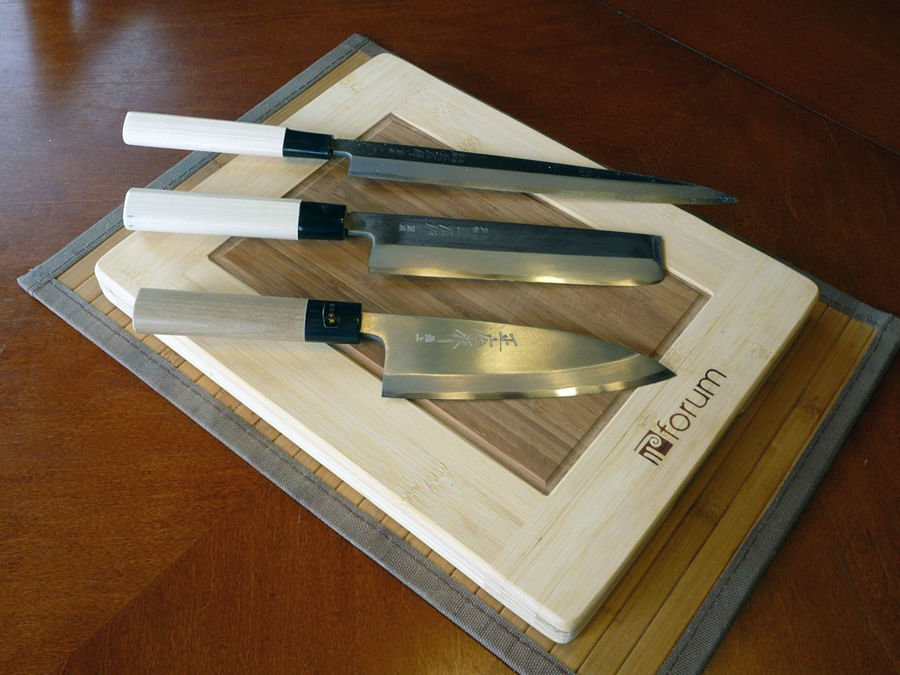
Japanese food is a gastronomical delight. The sight of neatly arranged and colourful food is enough to get the digestive juices going.
The Japanese clearly want food presentation to be as good as the taste. And Japanese chefs are very dedicated about what they do, making it akin to fine art.
Whether it is sushi, sashimi or any Japanese dish, the delicate way in which vegetables, meat and fish are cut is a sight to behold. Now, these fine and delicate cuts need extremely sharp knives and Japanese chefs use several types of knives for various functions.
Firstly, what makes Japanese knives special? It is their mastery of metallurgy. The Japanese have developed excellent metal working skills over the centuries, be it knives, swords or other tools.
Generally, the steel used in Japanese knives is much harder than in western countries. Since they are harder, the blade can be thinner and the knife will retain the edge longer. Simply put, Japanese knives need much less maintenance and sharpening.
HRC is the measure of steel hardness. German steel is known to be good and its hardness rating is typically from HRC 52-56. But Japanese steel has hardness ratings from HRC 58-65. So, German knife blades tend to be thicker than Japanese ones.
Also, since they are made of harder steel, Japanese knives can be sharpened to a finer edge and angle. This means that cutting is an easier task. It is also a general rule that a sharp knife is much safer than a dull one. A sharp knife will cut the vegetable easily, while there is every chance that the vegetable will slip under a dull knife and injure the user.
The other unique aspect of some Japanese knives is that they are single bevel, meaning that the blade is sharpened only on one side and the other side is flat. Single bevel knives can be sharpened to a finer edge than double bevel knives. A finer edge means more delicate cuts can be achieved.
The traditional western way of cutting vegetables, meat or fish is using the downward and forward cutting action. However, Japanese chefs cut using a backward stroke with only the front tip of the knife making contact with the cutting board. This helps in retaining the sharpness of the edge longer.
In Japanese cooking, there are specific knives for various tasks. DH lists some of the prominent ones:
Single bevel knives:
Yanagiba: This is a thin and long knife that is used to cut raw fish and seafood. This is an important knife for sushi chefs because it enables them to make one single neat cut through delicate and soft food.
A variant of the Yanagiba is the Takohiki, which is also long but the blade has a square end. The Yanagiba has a regular pointed tip.
Deba: This is a thick and heavy knife that is meant for gutting fish or cutting through rib bones.
Honesuki: This is a boning knife and used to cut meat and poultry. Garasuki is a variant of this and used to cut through bones.
Usuba: The name means thin blade. This exceptionally sharp knife is used to cut harder vegetables like carrot. This knife is used to make precise cuts through other vegetables.
Mukimono: This is similar to an Usuba but has a pointed tip. This is used for decorative vegetable cutting.
Double bevel knives:
Gyutou: This is the equivalent of a western chef knife. The blade is thin and can have a sharper edge. This can be used to chop and slice vegetables, fruit, meat and fish.
Sujihiki: These are long knives and used to cut meat and usually with a draw cut (slicing backwards).
Nakiri: This knife has a rectangular blade and is meant to slice vegetables.
Santoku: Meaning three virtues, a Santoku knife is a cross between a Gyutou and Nakiri. This is generally used for cutting vegetables and fish.